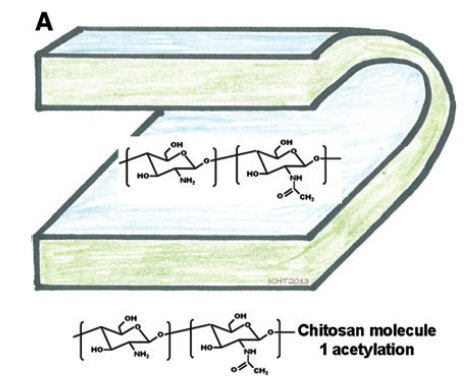Damage to the Peripheral Nervous System (PNS) is remarkably common and occurs mainly as a result from trauma or complications of surgery [1]. Although recovery of nerve function occurs in some mild injuries, outcomes are frequently poor following severe trauma, resulting in long-term impairment of limb function, dysaesthesia and pain, often with associated psychological effects [2]. As consequence, this issue has been raising major concerns in regenerative medicine for several years as unsatisfactory recovery continues to be a significant clinical challenge [3].
Chitosan, because of its good biocompatibility and physicochemical properties has been proposed as a biomaterial for tackling peripheral nerve injuries [4]. The Degree of Acetylation (DA) is a key parameter that can be controlled and has a major impact on material properties [5],[6]. According to the literature, decreasing DA leads to greater Schwann cell adhesion [6]-[8]. In this study, chitosan films with three low and different DAs (DA I ~ 1%; DA II ~ 2% and DA III ~ 5%) were produced from Altakitin medical grade chitosan powders. Surface and bulk properties of the films were investigated by Scanning Electron Microscopy (SEM), Atomic Force Microscopy (AFM), Contact angle and Surface Energy measurements, FTIR, X-Ray Diffraction (XRD), Differential Scanning Calorimetry (DSC), Degradation and Water Uptake, Bioactivity and Mechanical Properties. Biological assays using a L929 cell line and Immortalized Schwann cells were also seeded on the materials in order to assess cell viability, adhesion and proliferation of these two cell types in the films. Results showed that by means of controlling DA of chitosan films it is possible to tune material characteristics, even at a molecular level which can be beneficial for adequately developing novel nerve conduits for peripheral nerve regeneration.

Altakitin; Biohybrid (EU-FP7-Health-2011-collaborative project 278612); Medovent
References:
[1] G. Ciardelli, and V. Chiono, Materials for peripheral nerve regeneration. Macromol Biosci, 2006. 6(1): p. 13-26
[2] A. S. Daar, and H.L. Greenwood, A proposed definition of regenerative medicine. J Tissue Eng Regen Med, 2007. 1(3): p. 179-84.
[3] J. Scheib, and A. Hoke, Advances in peripheral nerve regeneration. Nat Rev Neurol, 2013. 9(12): p. 668-676
[4] S. Gnavi et al., The use of chitosan-based scaffolds to enhance regeneration in the nervous system. Int Rev Neurobiol, 2013. 109: p. 1-62
[5] I. F. Amaral, et al., Rat bone marrow stromal cell osteogenic differentiation and fibronectin adsorption on chitosan membranes: the effect of the degree of acetylation. J Biomed Mater Res A, 2005. 75(2): p. 387-97
[6] T. Freier, et al., Controlling cell adhesion and degradation of chitosan films by N-acetylation. Biomaterials, 2005. 26(29): p. 5872-8
[7] C. Wenling, et al., Effects of the degree of deacetylation on the physicochemical properties and Schwann cell affinity of chitosan films. J Biomater Appl, 2005. 20(2): p. 157-77
[8] S. Wrobel, et al., In vitro evaluation of cell-seeded chitosan films for peripheral nerve tissue engineering. Tissue Eng Part A, 2014. 20(17-18): p. 2339-49